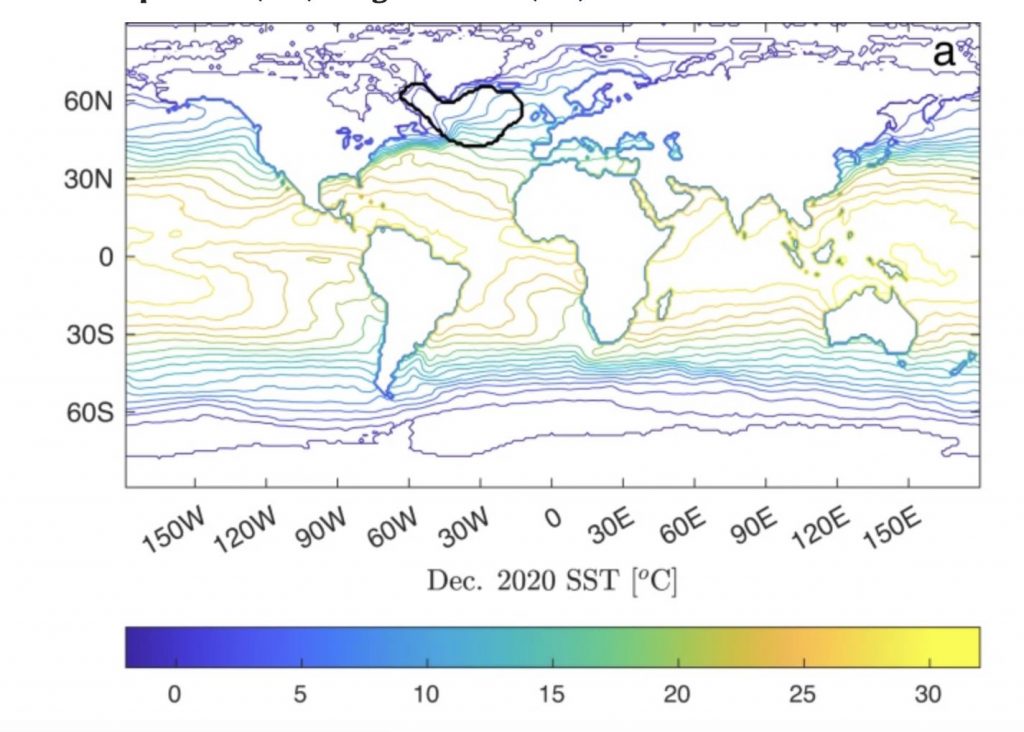When a recent study, published in Nature Communications, suggested that the Atlantic Meridional Overturning Circulation (AMOC) was closer to a crucial tipping point than previously thought, images of the 2004 Hollywood Blockbuster movie The Day After Tomorrow – where a rapid melting of polar ice, caused by global warming, alters ocean currents, interrupts the Gulf Stream and leads to a new ice age in a matter of hours – abounded in media reports.
Although the scale and swiftness of the disaster shown in the film represents a laughably unrealistic scenario that was challenged by sceintists, what the computer generated images and special effects did manage to convey was the existence of a tipping point connected to sea currents in the Atlantic Ocean.
A concept that the recent Nature Communications’ study brought back into the limelight by suggesting that radical change to our climate may be a lot closer than previously thought and that global warming is pushing us towards yet another critical tipping point.
Here's a thread in pictures about the Atlantic overturning circulation #AMOC which is making headlines this week. I've studied this topic since 1991 and will show key data and models & some video.
Let's go: observed temperature trend since 1901 from https://t.co/jGHxmrjzLG 🧵1/x pic.twitter.com/TdnNt1OYeT— Prof. Stefan Rahmstorf 🌏 🦣 (@rahmstorf) July 28, 2023
What is the AMOC?
The AMOC is a system of ocean currents that circulates warm water towards the northern part of the Atlantic Ocean and cold water to the south.
As warm surface water moves towards the poles (like the Gulf Stream in the North Atlantic), it loses heat and gains density (if salinity remains constant). In turn, this leads to what is known as overturning whereby the denser water sinks, and travels southward in the deep ocean layers. Eventually, this water rises back up to the surface, warms, and undergoes a process known as upwelling, thus coming full circle.
The entire circulation cycle of the AMOC operates at a relatively sluggish pace. It can take approximately 1,000 years for a unit of water, such as a cubic meter, to complete its journey along this conveyor belt.
Although this is a natural cycle which has varied in pace throughout history, there is growing evidence that the AMOC is slowing down as our climate continues to warm due to emissions from human activities, which in turn will have far reaching repercussions.
“The AMOC may be weakened due to the change in the water temperature and salinity,” explains Dr. Dorotea Iovino, Lead Scientist of Global ocean and sea ice modeling research unit at the CMCC. “There is evidence from theory, simplified and complex climate models, and paleo observations of significant and abrupt changes in the overturning circulation that could weaken and collapse into a state of reduced flow in the future with relevant climate impacts.”
However, what remains unclear is if and when an abrupt weakening of the AMOC will occur. “To what degree, how fast, and when these changes will happen are still open questions,” says Iovino.
A key climate tipping point
Although there is uncertainty as to when an abrupt weakening in the AMOC may occur, there is a scientific consensus around its standing as a major tipping point in the climate system and that not only a collapse but also a significant slowing would have significant impacts, not only in the North Atlantic region but across the globe.
“The circulation system currently transports vast amounts of heat northward across the entire Atlantic Ocean,” says Iovino. If it were to cease functioning, over the span of a few decades, we would witness significant cooling of surface temperatures, rising sea levels in the Atlantic Ocean, and intensified winds throughout the northern hemisphere.

Some of the most likely impacts also include radical shifts in rainfall patterns which could lead to drought in regions such as Europe, North America, northern Africa, and Asia. In contrast, areas such as the Amazon, Australia, and southern Africa may experience increased rainfall.
“Arctic sea ice would extend further into the subpolar North Atlantic, and Antarctic sea ice would expand northward. Moreover, the AMOC slowdown would exacerbate tropical warming, where elevated temperatures are already creating challenging living conditions,” says Iovino.
Although the changes described by Dr. Iovino are present in numerous climate models, there is still a lot of uncertainty as to the magnitude of these changes.
“Historical observations offer a clue as to what some of the consequences may be as the AMOC has switched on and off repeatedly, triggering rapid changes in temperatures and precipitation patterns around the North Atlantic and beyond,” says Iovino.
Scientists believe that the last time the Amoc went through a repeated stop and restart cycle was during the Ice Ages, about 115,000 to 12,000 years ago.
Will it tip this century?
According to Peter Ditlevsen, lead author of the Nature Communications’ study, as the planet continues to warm the AMOC may collapse much sooner than previously: anytime between now and 2095, and even as early as 2025.
“These results need to be treated with caution,” says Iovino. “The study uses statistical techniques applied to a long time series of proxy AMOC data based on indirect measurement (sea surface temperature in the north Atlantic). However, there is still no consensus on which proxies can accurately capture the long term AMOC behavior. The surface temperature might not provide the best indicator and the study also ignores a range of processes that may be important for shaping the observed changes over the North Atlantic,” continues Iovino.
Ditlevsen’s study is also at odds with the most recent report from the United Nations Intergovernmental Panel on Climate Change, where a variety of climate models concluded with medium confidence that the AMOC will not fully collapse this century.
AMOC collapse would be a massive, planetary-scale disaster
Even if there were just a 40% chance Ditlevsen study is correct in tipping point being reached between 2025 and 2095, that’s a major change to previous IPCC assessment that risk is less than 10%.https://t.co/l9BYvEvexq— GO GREEN (@ECOWARRIORSS) September 5, 2023
Although the question of if and when the AMOC might reach a tipping point is an ongoing debate, climate models indicate that it is giving strong signals that it will weaken over the course of the 21st Century, particularly when considering high emissions pathways. However, there are very few models that simulate an imminent collapse.
“It is important to mention that, in the new paper, the time period of potential collapse depends on choices they have made in how they construct the time series of sea surface temperature which they use as evidence for change,” says Iovino. “They present three versions of the temperature records, and the three resulting model predictions suggest a collapse is ‘likely’ at any time from 2024 to 2180. The 2025-2095 is the period of time their statistical model predicts that a full or partial collapse is most likely.”
As scientists continue to monitor AMOC variability and improve our understanding of its stability under present and future climate conditions, what is certain is that this is “yet another warning that we should accelerate action to decarbonize the economy and get to net zero greenhouse gas emissions as soon as possible,” concludes Iovino.
Cover picture by: USGS @Unsplash






